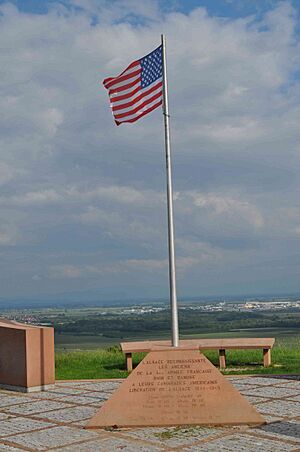Colmar Pocket facts for kids
Quick facts for kids The Colmar Pocket |
|||||||
|---|---|---|---|---|---|---|---|
| Part of World War II | |||||||
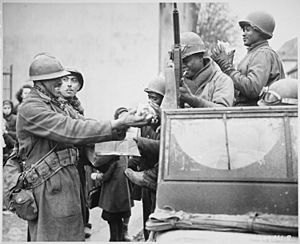 U.S. and French forces link up at Rouffach, February 1945. The junction of the two forces split the Colmar Pocket. The soldier on the left is wearing the distinctive French pre-occupation Adrian helmet. |
|||||||
|
|||||||
| Belligerents | |||||||
| Commanders and leaders | |||||||
|
|
||||||
| Strength | |||||||
Initial:
|
|
||||||
| Casualties and losses | |||||||
|
At least 22,000; possibly as high as 38,500 | ||||||
The Colmar Pocket was a tough battle during World War II in a part of France called Alsace. From November 1944 to February 1945, German forces held onto this area, even though the U.S. 6th Army Group had freed most of the surrounding land. It was like a "pocket" because the German army was surrounded on three sides.
In January and February 1945, the French First Army, with help from the U.S. XXI Corps, fought hard to push the German forces out of this pocket. This battle was a key step in the Allies' plan to clear France and move into Germany.
Why the Colmar Pocket Existed
How the Pocket Formed
In November 1944, the Allies were pushing hard through France. The U.S. 6th Army Group broke through German defenses in the Vosges Mountains. French forces reached the Rhine River in the south, near the Swiss border. At the same time, another French division, working with the U.S. Seventh Army, reached the Rhine in the north, freeing Strasbourg.
These two advances trapped a large group of German soldiers on the west side of the Rhine River. This trapped area, centered around the city of Colmar, became known as the "Colmar Pocket." It was like a bubble of German control in an area that was mostly freed by the Allies.
Why Germany Fought So Hard
Alsace and Lorraine were areas that Germany had claimed as their own for a long time. Because of this, Adolf Hitler ordered his army to defend the Colmar Pocket very strongly, as if it were German soil. The Germans needed to keep control of bridges over the Rhine River at Breisach and Chalampé. These bridges were super important for bringing in supplies and for their troops to escape if needed.
Challenges for the Allies
By late 1944, the Allied armies were tired from months of fighting. They also had trouble getting enough supplies, like artillery shells, and finding enough new soldiers to replace those who were injured or killed.
The French army had its own problems. Many of their experienced soldiers had been fighting in Italy and were very tired. They were replaced by new, less experienced troops. These new soldiers were good at defending, but they needed more training for attacking. This made it harder for the French to push the Germans out of the pocket.
More Allied Troops Arrive
In January 1945, the Germans tried a big attack called Operation Nordwind. Part of this attack involved German troops trying to break out of the Colmar Pocket to the north. The French stopped them, but it showed that more help was needed.
So, General Jacob Devers, who led the U.S. 6th Army Group, sent more American soldiers to help the French. The U.S. 3rd Infantry Division and the U.S. 28th Infantry Division were moved into position. Later, the U.S. 12th Armored Division also joined the fight.
Winter Weather and Difficult Land
The winter of 1944-1945 was extremely cold, with temperatures dropping to -20°C (-4°F) and deep snow. The land around Colmar was mostly flat, with few places for soldiers to hide. It was also full of streams and canals, which were hard for vehicles to cross. Small villages with strong stone houses gave the German defenders good views and strong positions.
The Battle Begins
French Attack in the South
On January 20, 1945, the French I Corps began its attack. They faced tough German defenses and very difficult weather. The French soldiers fought through snowstorms and against German counterattacks. They also faced many land mines, which destroyed many of their tanks.
Even with these challenges, the French slowly gained ground. They pushed several miles northeast, especially in the western part of their attack zone. On January 24, a German tank attack was stopped by the French, who destroyed 15 German tanks. But overall, the French advance was slow and costly.
Allied Attack in the North
On January 22-23, the French II Corps launched its attack in the north. This attack included the U.S. 3rd Infantry Division and the French 1st March Infantry Division.
Pushing to the Colmar Canal
The U.S. 3rd Infantry Division aimed to cross the Ill River, go around Colmar, and open a path for French tanks. Their goal was to reach a key railway bridge at Neuf-Brisach, which was important for German supplies.

One brave soldier, Private First Class Jose F. Valdez, showed amazing courage on January 25. He was at a small railway station when his squad was in danger. He stayed behind, covering their retreat, and was killed doing so. He was later given the Medal of Honor.
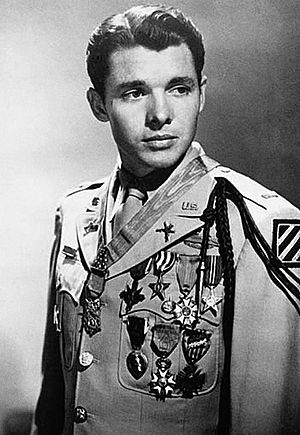
Another incredible act of bravery happened on January 26. Lieutenant Audie Murphy of the U.S. 15th Infantry Regiment was in the Riedwihr Woods when his company was attacked by German tanks and infantry. He ordered his men to pull back, then climbed onto a burning tank destroyer. He used its machine gun to fight the Germans all by himself, even calling for artillery to fire on his own position! This confused the Germans, and they were later bombed by U.S. planes. Murphy then chased the retreating Germans. He also received the Medal of Honor.
The U.S. troops fought hard, taking towns like Riedwihr and Holtzwihr. By January 29, they reached the Colmar Canal.
Reaching the Rhine in the North
North of the U.S. 3rd Division, the French 1st March Infantry Division also pushed east towards the Rhine River. They faced strong German defenses, including many land mines. The French fought through villages and forests, slowly but surely gaining ground. On January 28, they took the village of Grussenheim with the help of French tanks. By January 31, they reached the Rhine River, completing their mission in that area. This was a tough fight for the French, who suffered many casualties.
More Allied Help Arrives

Because the fighting was so difficult, more U.S. troops were sent to help. The U.S. XXI Corps headquarters took charge of the U.S. 3rd and 28th Infantry Divisions, and two more U.S. divisions, the U.S. 75th Infantry Division and the U.S. 12th Armored Division, were added. Their main goal was to capture the city of Colmar and push towards the bridge at Breisach.
The Germans, meanwhile, were confused about the Allied plans. Hitler ordered them not to retreat fully. This led to German units getting mixed up, which made their defense weaker.
Pushing to the Rhine in the Center
On January 29, the U.S. 3rd Division launched a huge attack across the Colmar Canal. Engineers quickly built bridges for tanks to cross. French tanks then joined the U.S. infantry, and they captured the town of Urschenheim.
Another hero, Technician 5 Forrest E. Peden from the 3rd Division artillery, bravely ran through heavy German fire on February 3 to get help for an infantry unit that was trapped. He was killed when his tank was hit on his return. He was also given the Medal of Honor after his death.
By February 1, U.S. troops were nearing Neuf-Brisach. On February 6, the fortified town of Neuf-Brisach was captured with the help of two French children and another civilian who showed the Americans safe paths into the town. The Germans blew up the bridge over the Rhine at Breisach as they left. This meant the U.S. 3rd Infantry Division's part in the battle was over.
Clearing the Pocket Around Colmar
The U.S. 75th Division joined the front lines on January 31. They attacked on February 1, clearing towns like Horbourg and Andolsheim. They also helped by making attacks that distracted the Germans from the main Allied push on Colmar. By February 6, the 75th Division reached the Rhône-Rhine Canal, finishing their role in the battle.
Colmar is Liberated
On February 2, the U.S. 28th Division, with French tanks, began the attack on the city of Colmar itself. They crossed an anti-tank ditch, and French tanks found a way into the city. By February 3, the city was mostly cleared of Germans. In a special moment, the French 152nd Infantry Regiment, which had been stationed in Colmar before the war, re-entered the city. Other units of the 28th Division helped block German escape routes from the Vosges Mountains.
Splitting the Colmar Pocket
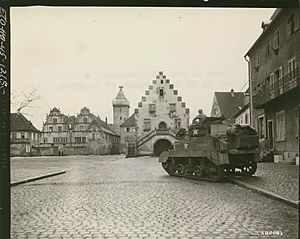
On February 3, the U.S. 12th Armored Division moved south to meet up with the French I Corps. Their goal was to split the Colmar Pocket in two. On February 5, the American tanks entered Rouffach and finally met with the French 4th Moroccan Mountain Division. This meeting officially split the German pocket, making it much harder for the Germans to fight.
The Colmar Pocket Collapses
In early February, the French I Corps continued to clear out German resistance in the southern part of the pocket. They crossed the Thur River and pushed towards Rouffach. On February 5, the French 4th Moroccan Division linked up with the U.S. 12th Armored Division in Rouffach.
The shrinking German forces on the west side of the Rhine were hit hard by artillery and airstrikes. Finally, on February 9, the French I Corps cleared the last German troops at Chalampé. With no major German forces left on the west bank of the Rhine, the Germans blew up the bridge at Chalampé. This marked the end of the Colmar Pocket battle and the end of any major German presence in Alsace.
After the Battle
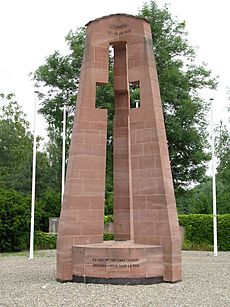
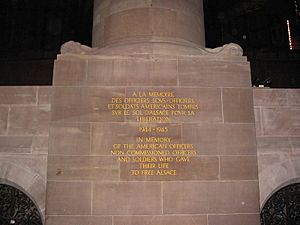
The Colmar Pocket was gone, and the U.S. 6th Army Group now stood along the entire Rhine River in that area. The German 19th Army lost most of its experienced soldiers and had to rebuild with new, untrained troops. The Germans left behind many armored vehicles and artillery pieces. Clearing the Colmar Pocket allowed the Allies to focus on their next big step: invading Germany.
For the fourth time in 75 years, the region of Alsace had changed hands between France and Germany.
After the battle, the French honored the U.S. 3rd Infantry Division and the U.S. 109th Infantry Regiment (from the 28th Division) with special awards for their bravery.
Today, you can find many streets in Alsace named after the Allied commanders and units who fought in this battle. There are also French and U.S. military cemeteries in the area, honoring those who gave their lives.
See also
- Allied advance from Paris to the Rhine
- Alsace campaign
- Battle of the Bulge
- Liberation of France
- Operation Nordwind



